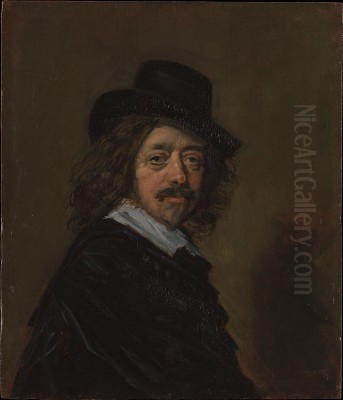
Frans Hals stands as one of the titans of the Dutch Golden Age, a period of extraordinary artistic flourishing in the 17th-century Netherlands. Born likely in 1582 in Antwerp and passing away in Haarlem in 1666, Hals dedicated his long career primarily to portraiture, revolutionizing the genre with his remarkably lively and spontaneous style. He moved beyond the stiff formality often seen in earlier portraits, capturing the fleeting moments, the genuine smiles, and the inherent character of his sitters with unprecedented immediacy. His work provides a vibrant panorama of Dutch society and his innovative techniques would echo through the centuries, influencing artists long after his own time.
Early Life and Artistic Formation
Frans Hals was born in Antwerp, then part of the Spanish Netherlands (now Belgium), around 1582. His parents, Franchois Hals van Mechelen, a cloth merchant, and Adriaentje van Geertenryck, fled Antwerp for the Northern Netherlands after the city fell to the Spanish Duke of Parma during the Eighty Years' War. Like many Protestant refugees seeking religious freedom and economic opportunity, the Hals family settled in Haarlem, a prosperous city west of Amsterdam, likely around 1585. It was in Haarlem that Frans Hals would spend the vast majority of his life and build his formidable artistic career.
Details about his early training are scarce. The influential artist, writer, and theorist Karel van Mander mentioned Hals briefly in his Schilder-boeck (Book of Painters) of 1604, but only in reference to another artist. While some speculate Hals may have studied briefly with Van Mander before the latter's death in 1606, concrete evidence is lacking. What is clear is that by 1603, Hals had already acquired significant painting skills. His official entry into the Haarlem Guild of Saint Luke in 1610 confirms his status as an independent master, ready to take on commissions and apprentices.
The Haarlem Milieu and Artistic Maturity
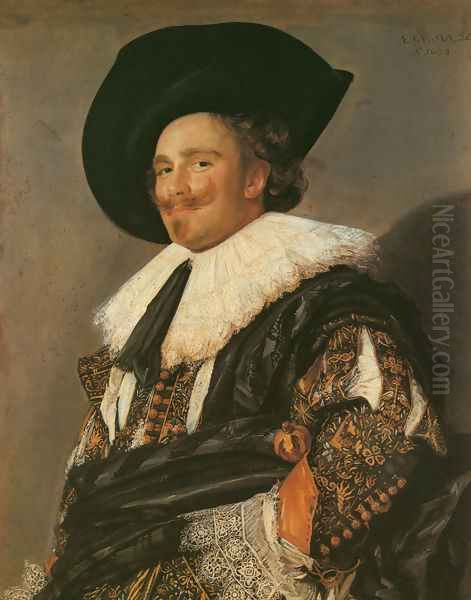
Haarlem in the early 17th century was a bustling center of trade, industry (particularly brewing and textiles), and culture. This environment provided fertile ground for artists, with a growing affluent middle class eager to commission portraits as markers of status and identity. Hals quickly established himself within this milieu. His membership in the Guild of Saint Luke was a crucial step, granting him the rights and recognition of a professional artist in the city.
He also became involved in civic life, joining the St. George civic guard company (Sint-Jorisdoelen) in 1612. Membership in these militia groups was common for men of standing, and these associations would prove vital for Hals's career, leading to major group portrait commissions that became some of his most celebrated works. He spent almost his entire working life in Haarlem, with records indicating only one significant trip back to Antwerp in 1616, possibly to study the works of Flemish contemporaries like Peter Paul Rubens and Jacob Jordaens.
A Revolutionary Portrait Style
What truly set Frans Hals apart was his revolutionary approach to portraiture. He broke decisively with the meticulously detailed and often rigid conventions that characterized much portrait painting of the time. Instead, Hals developed a style marked by visible, dynamic brushstrokes, a technique often described as "alla prima" (wet-on-wet), suggesting speed and spontaneity. This approach allowed him to capture a sense of immediacy and life, freezing moments of animation – a laugh, a glance, a gesture – with uncanny skill.
His brushwork was remarkably varied and expressive. In some areas, particularly faces and hands, he could apply paint with broad, confident strokes, while in others, like lace collars or fabrics, he employed finer, more descriptive touches. This technique, often appearing almost sketch-like up close, resolves into a startlingly realistic and vibrant image when viewed from a distance. His use of color was equally bold and free, contributing to the overall liveliness of his compositions. Critics and artists later recognized this innovative style; indeed, some have dubbed him a "precursor to Impressionism" for his emphasis on capturing light, movement, and the fleeting moment through visible brushwork.
Masterpieces and Major Commissions
Hals's oeuvre is rich with masterpieces that exemplify his unique talent. Among his most famous individual portraits is The Laughing Cavalier (1624, Wallace Collection, London). Despite the title (assigned later), the subject isn't actually laughing but wears an enigmatic smile. The painting is renowned for its dazzling depiction of the sitter's ornate costume and, more importantly, the palpable sense of presence and personality conveyed through the confident pose and direct gaze.
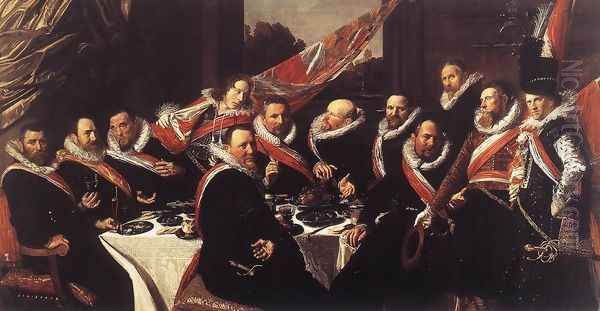
His group portraits, particularly those commissioned by Haarlem's civic guard companies, are monumental achievements. Works like The Banquet of the Officers of the St. George Civic Guard (1616 and later versions, Frans Hals Museum, Haarlem) revolutionized the genre. Instead of arranging the figures in static rows, Hals created dynamic, interactive scenes, capturing the camaraderie and boisterous energy of these militia banquets. Each individual is distinctively portrayed, yet integrated into a cohesive and lively composition.
Later in his career, his style evolved, becoming more subdued in color but perhaps even more profound in psychological depth. The pair of group portraits depicting the Regents and Regentesses of the Old Men's Almshouse (both c. 1664, Frans Hals Museum, Haarlem) are stark, powerful works from his final years. Painted with incredibly free and somber brushwork, they convey a sense of gravity and introspection, offering penetrating character studies of the charitable institution's board members. Other notable works include the Portrait of a gentleman, probably the Reverend John Livingston (c. 1650), showcasing his mature skill in capturing character through subtle expression and masterful handling of light, and the genre-like figure study Pekelharing (c. 1628-1630), which may show the influence of Flemish artists or theatrical characters.
Subjects and Society
Frans Hals's portraits offer an invaluable window into the diverse society of the Dutch Golden Age. Unlike some contemporaries who focused primarily on the elite, Hals painted individuals from a wide spectrum of Haarlem life. His sitters included wealthy merchants, brewers, civic guard officers, scholars, clergymen, artisans, fishwives, and even figures from the margins of society, often depicted in genre-like scenes known as "tronies" (character studies).
His commissions often came from the prosperous middle class – the backbone of the Dutch Republic. He painted numerous portraits of married couples, often as pendants (separate paintings intended to hang together). These works celebrate marital bonds and domestic prosperity. The large-scale group portraits of the civic guards and the regents of charitable institutions document the importance of collective identity and civic responsibility in Dutch society. Through his keen observation and expressive style, Hals captured not just the likeness but also the social roles, aspirations, and psychological nuances of his fellow citizens.
Contemporaries, Competitors, and Influences
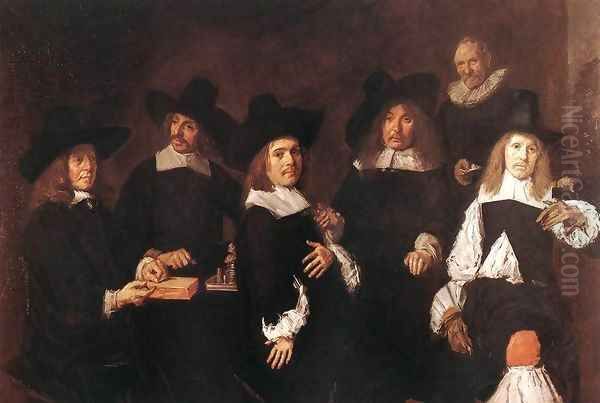
Hals operated within a vibrant artistic landscape. While his early training remains unclear, Karel van Mander is a possible, though unconfirmed, influence. His 1616 trip to Antwerp suggests an awareness of Flemish masters like Peter Paul Rubens and Jacob Jordaens. While Rubens's more polished, baroque style seems to have had limited direct impact on Hals, the lively "study heads" or tronies associated with Jordaens might have resonated with Hals's own interest in expressive character types.
Within Haarlem and the broader Dutch art scene, Hals faced competition. In portraiture, Pieter van der Merwe was a notable rival in Haarlem. On a larger stage, the Amsterdam-based Rembrandt van Rijn emerged as the other dominant force in Dutch portraiture. While both were masters of capturing psychological depth, their styles differed significantly. Rembrandt became known for his dramatic use of chiaroscuro (light and shadow) and deeply introspective mood, often achieved through meticulous layering and glazing. Hals, in contrast, prioritized immediacy, vibrant brushwork, and capturing the outward animation of his subjects.
There is evidence of interaction, or at least mutual awareness, with other major figures. Anthony van Dyck, the renowned Flemish portraitist who worked extensively in England, likely encountered Hals's work. An old anecdote, now largely dismissed by scholars as apocryphal, tells of Van Dyck visiting Hals's studio incognito. However, stylistic comparisons, such as the possible influence of Van Dyck on Hals's Pekelharing, suggest some level of artistic dialogue or shared currents, even if direct contact was limited.
The Workshop and Hals's Students
Like many successful masters of his time, Frans Hals maintained a busy workshop in Haarlem, training a significant number of pupils and employing assistants. His dynamic style and methods undoubtedly influenced those who studied under him. His most famous pupil was arguably Judith Leyster, one of the few female painters to achieve professional recognition in the Dutch Golden Age. Her work, such as The Jolly Toper, clearly shows Hals's influence in its lively brushwork and subject matter, though she developed her own distinct style.
Other documented or attributed pupils include Adriaen Brouwer (though primarily known for his peasant scenes), Jan Miense Molenaer (who married Judith Leyster), Adriaen van Ostade, and Philips Wouwerman (though both became more famous for genre scenes and landscapes, respectively). Hals's own brother, Dirck Hals, was also a painter, specializing in genre scenes, as were several of Frans Hals's sons, including Harmen, Frans II, and Nicolaes, though none achieved the fame of their father. Adriaen van der Vaart is also mentioned as a student who inherited and continued aspects of his technique.
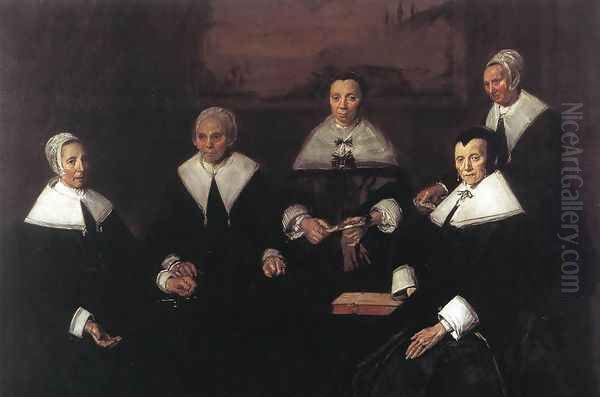
Despite the number of students associated with his studio, 19th-century art historians sometimes questioned the extent to which their styles truly mirrored the master's unique touch. Nevertheless, Hals's workshop was clearly an important center of artistic activity in Haarlem, disseminating his techniques and approach to a younger generation of artists.
Personal Life and Financial Struggles
Despite his artistic success and considerable fame during his lifetime, Frans Hals's personal life was marked by financial instability. He married twice. His first wife, Annetje Harmansdochter, died young in 1615, possibly during childbirth. Hals was left with two children. In 1617, he married Lysbeth Reyniers, with whom he would have at least eight more children. Supporting such a large family likely contributed to his financial pressures.
Archival records reveal that Hals was frequently in debt. He faced claims from creditors, including bakers, shoemakers, and fellow artists, throughout his career. While his portraits were sought after, he may not have commanded the consistently high prices of some contemporaries, or perhaps he was simply a poor manager of his finances. Stories passed down, particularly by the 18th-century biographer Arnold Houbraken, painted Hals as a drunkard and dissolute character. However, modern scholarship finds little concrete evidence to support these claims, suggesting they may be exaggerations or misinterpretations. His late portraits of the almshouse regents, painted when he himself was receiving support from the institution, add a layer of poignancy to his final years. The anecdote that his first wife's daughter received only a simple funeral further hints at his persistent financial difficulties.
Descriptions suggest a personality that was energetic, perhaps even boisterous, fitting the lively nature of his art. He was reportedly cheerful and enjoyed social gatherings. However, he was also described as potentially blunt, stubborn, or irritable, traits that might have complicated patronage relationships or financial dealings in the socially nuanced world of 17th-century Haarlem.
Rediscovery and Enduring Legacy
After his death in 1666, Frans Hals's reputation gradually faded. While never entirely forgotten, his loose, painterly style fell out of fashion during the 18th and early 19th centuries, which favored more polished, academic finishes. His works sometimes sold for negligible sums; one instance records a painting fetching a mere five shillings in 1786.
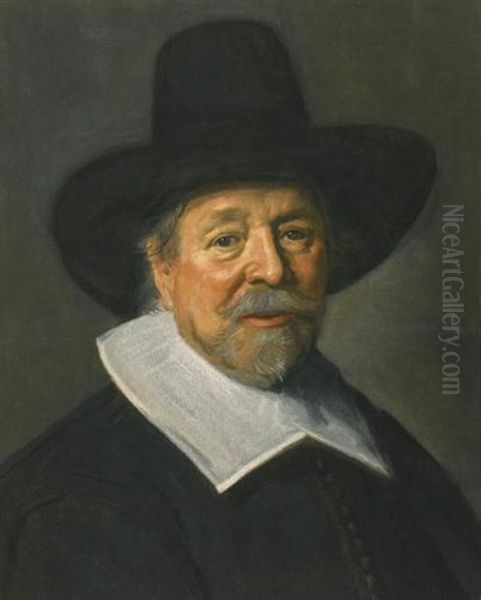
The tide began to turn dramatically in the mid-19th century, largely thanks to the advocacy of the influential French art critic Théophile Thoré-Bürger (who also rediscovered Vermeer). Thoré-Bürger championed Hals's work, praising its realism, vitality, and technical brilliance. This reassessment coincided with the rise of Realism and Impressionism, movements whose practitioners found Hals's style deeply resonant.
Artists like Gustave Courbet, Édouard Manet, and later, the Impressionists, admired Hals's bold brushwork, his ability to capture fleeting effects of light, and his unvarnished portrayal of character. Manet, in particular, traveled to Haarlem to study Hals's paintings, and their influence is visible in his own work. Vincent van Gogh was another fervent admirer. In a letter to his brother Theo, Van Gogh expressed his delight in Hals's directness: "What a joy it is to see a Frans Hals, how different it is from the paintings – so many of them – where everything is carefully smoothed out in the same way." Other major figures like Edgar Degas and Eugène Delacroix also recognized his genius. Even 20th-century masters like Pablo Picasso reportedly studied and copied Hals's work. Hals came to be seen not just as a master of his own time, but as a vital precursor to modern art, celebrated for his technical freedom and expressive power.
Hals in the Art Market
Reflecting his historical reputation, the market for Frans Hals's work has seen dramatic shifts. Following the period of neglect, the 19th-century revival sparked renewed collector interest. A key moment was the 1865 Paris auction of The Laughing Cavalier, which fetched 51,000 francs – a price far exceeding expectations and signaling Hals's return to prominence among collectors.
In the 20th and 21st centuries, works by Hals have commanded significant prices, although the supply of major pieces coming to market is limited, as many are held in museum collections. Recent notable sales include a portrait of a gentleman from the De Wolff family selling for £4.7 million at Christie's, described as its highest price in nearly a century. In 2018, another portrait set a personal auction record for Hals, selling for €12.5 million, also at Christie's. A 1635 Portrait of a Man, Half-Length was offered at Sotheby's in 2020 with an estimate of £2-3 million, indicating continued strong demand.
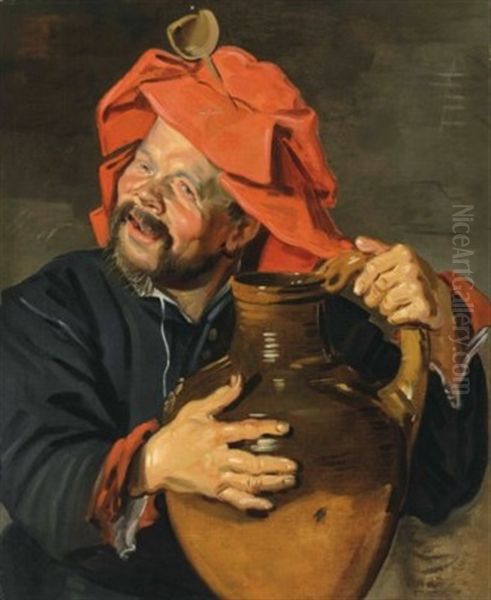
However, the market is not without challenges. The high value of his work has inevitably attracted forgers. A significant incident occurred in 2016 when a painting previously attributed to Hals and sold via Sotheby's was declared a modern forgery, causing a temporary stir and highlighting the complexities of authenticating Old Master paintings. Despite such issues, genuine works by Frans Hals remain highly coveted by major museums and private collectors worldwide.
Conclusion: Hals's Place in Art History
Frans Hals remains a pivotal figure in the history of Western art. As a leading master of the Dutch Golden Age, he fundamentally transformed portraiture, moving it away from static representation towards dynamic, psychological engagement. His innovative technique, characterized by visible, energetic brushwork, captured the vitality of his subjects with unparalleled immediacy and laid the groundwork for future generations of painters.
He provided a vivid chronicle of 17th-century Dutch society, depicting its citizens from various walks of life with insight and verve. While his personal life may have been fraught with financial difficulty, his artistic vision remained bold and uncompromising throughout his long career. Rediscovered and celebrated by 19th-century artists, his influence extended through Realism, Impressionism, and into Modernism. Today, his works are treasured highlights in major international museums, including the Frans Hals Museum in Haarlem, the Rijksmuseum in Amsterdam, the Metropolitan Museum of Art in New York, the National Gallery in London, and the Louvre in Paris, securing his legacy as a true master of capturing the human spirit.